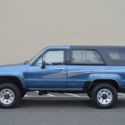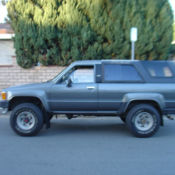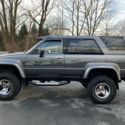1989 Toyota 4runner SR5 3.0L / 5 Speed / 4X4
- Condition: Used
- Make: Toyota
- Model: 4Runner
- Trim: SR5
- Year: 1989
- Mileage: 135,655
- VIN: JT3VN66WXK0033908
- Color: RED
- Engine size: 3.0
- Number of cylinders: 6
- Fuel: Gasoline
- Transmission: Manual
- Drive type: 4X4
- Interior color: RED
- Vehicle Title: Clear
- Location: Verona, New Jersey, United States
Description
You are bidding on an immaculate, garage-kept Toyota 4Runner SR5 4x4. The truck has it's original factory radio, rear roll bar, dash board, factory interior, original removable hardtop, AC (works great), heat, power steering, power brakes, power windows, power door locks, power antenna, rear window which works by in-cab switch or back door key, new interstate battery etc.The interior of truck is in immaculate condition with all original options.
Exterior: Paint looks amazing with a few door dings, passenger front fender has surface rust spot (Not rot) in small area, passenger side rear corner of the hard top has a few scratches.
Frame/Drivetrain: In amazing condition with no rust or rot
The truck is being sold as is with no warranty and encourage you to come see vehicle before end of auction.
Truck will need to be trailered due to no insurance or plates.
4RUNNER HISTORY
The first generation is nearly mechanically identical to the Toyota Hilux. All first generation 4Runners had two doors and were indistinguishable from the pickups from the dashboard forward. Nearly all changes were to the latter half of the body; in fact, because the rear springs were not upgraded to bear the additional weight from the rear seats and fiberglass top, these early models tended to suffer from a sagging rear suspension.
In North America, they were sold from the 1984½model yearfrom May 1984. For this first year (March to July 1984 production), all models were equipped with black or white fiberglass tops. An SR5 trim package was offered that upgraded the interior: additional gauges, better fabrics, and a rear seat were standard with the package. All 1984 models were equipped with thecarbureted2.4L22Rengine and were all available with afour-wheel-drivesystem that drove the front wheels through a solid front axle.
1985 (August 1984 production) saw the arrival of the electronically fuel-injected 2.4L22R-Ealso called 22R-ECI4 engine. This upped the horsepower numbers from 100hp for the 22R, to 116hp for the 22R-E Engine, though the carbureted engine remained available until 1988.
In 1988, the 22R-E engine was joined by an optional 3.0L V6 engine, the 3VZ-E. This engine was significantly larger and more powerful although not as reliable as the original 4-cylinder offering. Trucks sold with the V6 engine were equipped with the same heavy duty rear differential that was used in the turbocharged trucks, as well as a completely new transmission and transfer case; the transfer case was chain driven, although considered less rugged, created less cab noise than the old gear-driven unit used behind the four-cylinder engine.
SOURCE: WIKIPEDIA
 1989 TOYOTA 4RUNNER 4X4 5 SPEED OFFROAD
1989 TOYOTA 4RUNNER 4X4 5 SPEED OFFROAD
Mileage: 266,000
 1989 TOYOTA 4RUNNER SR5 EFI 3.0L V6 4X4 5-SPEED MANUAL TRANS. 106,292 MILES
1989 TOYOTA 4RUNNER SR5 EFI 3.0L V6 4X4 5-SPEED MANUAL TRANS. 106,292 MILES
Mileage: 106,292
 1989 Toyota 4Runner SR5 Deluxe 3.0L V6 EFI Original Owner 144,900 mi AC 5 speed
1989 Toyota 4Runner SR5 Deluxe 3.0L V6 EFI Original Owner 144,900 mi AC 5 speed
Mileage: 144,900
 1989 Toyota 4Runner SR5 V6 - 5 speed - NC Car - 3 Owners - Maintenance Records
1989 Toyota 4Runner SR5 V6 - 5 speed - NC Car - 3 Owners - Maintenance Records
Mileage: 372200
 1989 Toyota 4Runner Great body and better engine DLX 5 speed 2.4 L 22R-E
1989 Toyota 4Runner Great body and better engine DLX 5 speed 2.4 L 22R-E
Mileage: 195,548
 1989 Toyota 4Runner Deluxe 4X4 Sport Utility 2-Door 120,000 4-Cyl 5-Speed
1989 Toyota 4Runner Deluxe 4X4 Sport Utility 2-Door 120,000 4-Cyl 5-Speed
Mileage: 120,000
 1989 Toyota 4Runner DLX - 5 Speed Manual - Fresh Paint & decals - Like New!
1989 Toyota 4Runner DLX - 5 Speed Manual - Fresh Paint & decals - Like New!
Mileage: 249706
 1989 Toyota 4Runner SR5 22RE 4 speed manual 1988 1987 1986
1989 Toyota 4Runner SR5 22RE 4 speed manual 1988 1987 1986
Mileage: 177,305
 SR5 Toyota 4Runner 1989
SR5 Toyota 4Runner 1989
Mileage: 151000
 1989 Toyota 4Runner
1989 Toyota 4Runner
Mileage: 311,000












